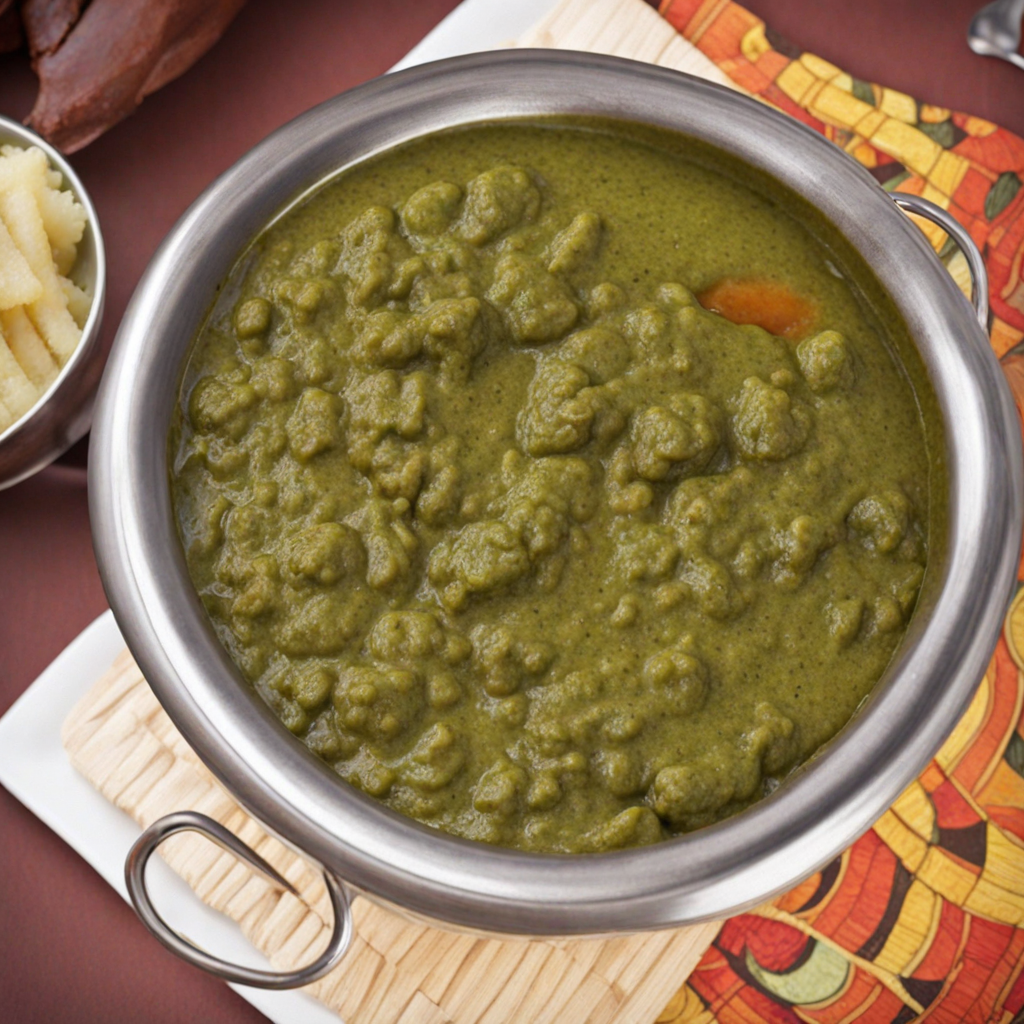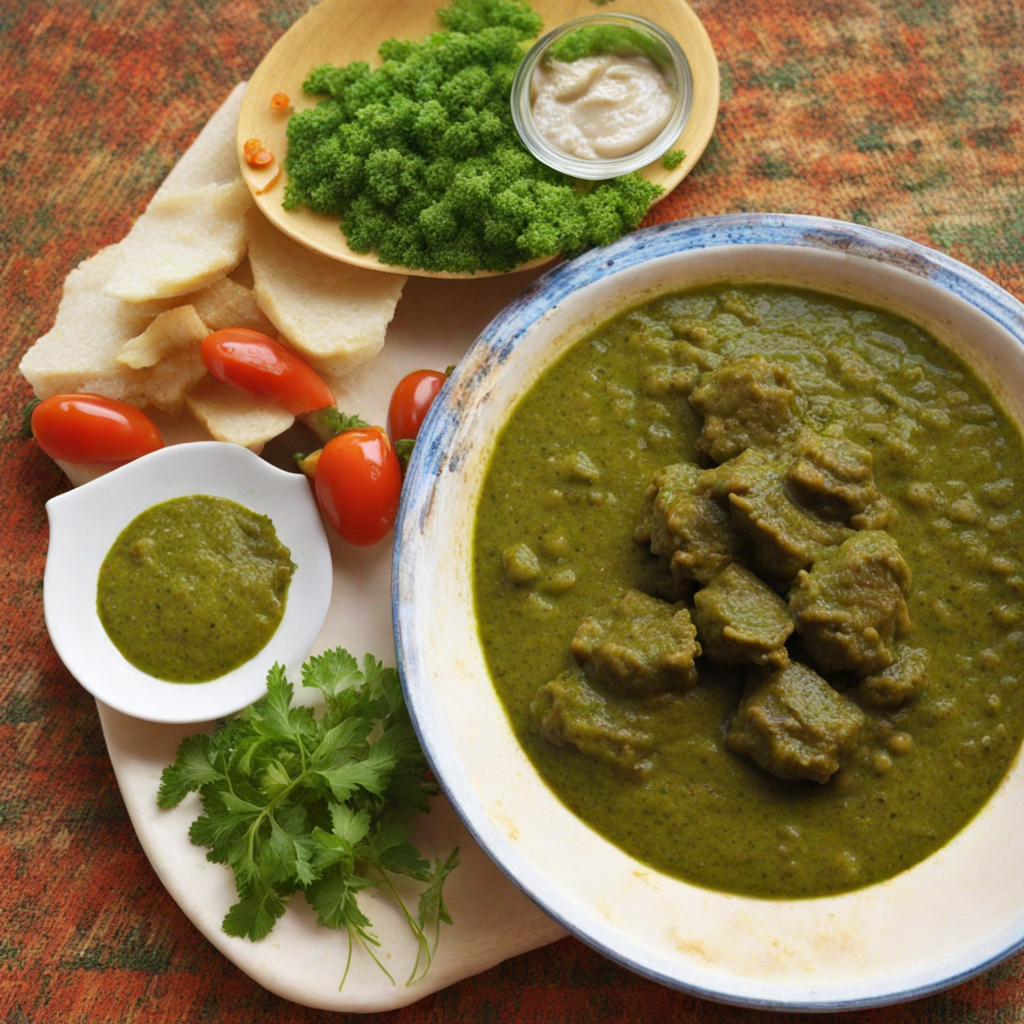Green Sauce with Meat
Sauce Verte, a vibrant and flavorful dish from Niger, reflects the rich culinary traditions of West Africa. This sauce, which translates to "green sauce," is renowned for its fresh ingredients and aromatic qualities. It plays a significant role in the local diet, often accompanying a variety of staples such as rice, millet, or boiled tubers. The origins of Sauce Verte can be traced back to the diverse agricultural practices of Niger, where the use of locally sourced vegetables and herbs is common, influenced by both the indigenous cultures and the historic trade routes that introduced new flavors and techniques. The flavor profile of Sauce Verte is a harmonious blend of earthy, herbal, and slightly spicy notes. The dominant taste comes from the combination of leafy greens and herbs, which can include ingredients like spinach, amaranth, or other local greens. These are often complemented by the addition of onions, garlic, and chili peppers, creating a depth of flavor that is both refreshing and comforting. The sauce is typically seasoned with salt and perhaps a squeeze of lime or lemon juice to enhance its brightness, making it a versatile accompaniment that can lift the flavor of any dish it accompanies. Preparation of Sauce Verte is relatively straightforward, emphasizing the freshness of the ingredients. The greens are first washed thoroughly to remove any grit, then chopped finely. In a separate pan, onions and garlic are sautéed in oil until they are soft and fragrant, forming the base of the sauce. Once the aromatics are ready, the chopped greens are added to the
How It Became This Dish
Sauce Verte: A Culinary Journey Through Niger's Rich Heritage Introduction Sauce Verte, or "green sauce," is a vibrant dish that epitomizes the culinary identity of Niger, a landlocked country in West Africa. With its roots deeply embedded in the agricultural practices and cultural traditions of the Nigerien people, Sauce Verte is more than just a condiment; it is a reflection of the region's biodiversity, culinary ingenuity, and community values. This exploration of Sauce Verte will delve into its origins, cultural significance, and the evolution of this beloved dish over the years. Origins of Sauce Verte The origins of Sauce Verte can be traced back to the rich agricultural landscape of Niger, where diverse crops thrive in the Sahelian climate. The primary ingredients of Sauce Verte consist of a variety of leafy greens, most notably the local sorrel, amaranth, and other indigenous herbs. These greens are often complemented by ingredients like tomatoes, onions, and spices, creating a vibrant and nutritious sauce that is both versatile and flavorful. Historically, Niger's population has relied on agriculture for sustenance, cultivating crops that adapt well to the arid conditions of the region. The reliance on locally available ingredients paved the way for the development of Sauce Verte. The use of greens in cooking has a long-standing tradition across West Africa, but Niger's unique blend of herbs and spices sets its Sauce Verte apart. Traditional methods of preparation, such as grinding and pounding ingredients using a mortar and pestle, are still prevalent, preserving the authentic flavors that have been passed down through generations. Cultural Significance Sauce Verte holds profound cultural significance within Nigerien society. It is often served as a staple accompaniment to dishes such as rice, millet, or fufu, providing a nutritional balance to meals. The vibrant green color of the sauce symbolizes prosperity, health, and connection to the earth, resonating with the agrarian lifestyle of many Nigeriens. In Nigerien culture, food is not merely sustenance; it is an integral part of community life and social gatherings. Sauce Verte is frequently prepared for special occasions, family gatherings, and communal feasts, where its preparation becomes a communal activity, fostering bonds among family and friends. The act of cooking together, sharing stories, and enjoying meals collectively highlights the importance of community in Nigerien culture. Moreover, Sauce Verte embodies the principles of sustainability and resourcefulness. The use of local greens and ingredients reflects a deep respect for the environment and an understanding of the interconnectedness of life. For many Nigeriens, cooking Sauce Verte is not just about the flavors but also about honoring their heritage, fostering a connection to the land, and ensuring that culinary traditions are preserved for future generations. Development Over Time As Niger has evolved, so too has Sauce Verte. The dish has adapted to incorporate various influences while retaining its traditional essence. With globalization and increased access to ingredients, contemporary variations of Sauce Verte may include the addition of proteins such as fish or meat, enhancing its nutritional value and appeal. Urbanization has also played a role, as city dwellers seek quick, convenient meals that still pay homage to their cultural roots. This has led to the emergence of pre-packaged versions of Sauce Verte, which are readily available in markets but may lack the depth of flavor found in traditional homemade versions. The culinary landscape of Niger is also influenced by the diverse ethnic groups that inhabit the region. The Hausa, Zarma, and Tuareg peoples, among others, have contributed to the rich tapestry of Nigerien cuisine. Each group brings its own culinary traditions, which can be seen in the variations of Sauce Verte. For instance, spices and flavor profiles may differ, with some regions favoring spicier versions while others lean toward milder flavors. This regional diversity enriches Sauce Verte, making it a dish that embodies the unity and diversity of Niger. In recent years, there has been a renewed interest in traditional foods, spurred by movements promoting local and sustainable eating. Chefs and home cooks alike are embracing the use of indigenous ingredients, revitalizing traditional dishes like Sauce Verte. This culinary renaissance emphasizes the importance of preserving Nigerien culinary heritage while also innovating and adapting to modern tastes. Conclusion Sauce Verte is more than just a green sauce; it is a symbol of Niger's agricultural heritage, cultural identity, and communal values. Its origins are rooted in the land, where the bounty of local crops has been celebrated for generations. The dish's cultural significance is evident in its role in social gatherings, where it fosters connections and embodies the spirit of togetherness. As Sauce Verte continues to evolve, it remains a testament to the resilience and adaptability of Nigerien cuisine. Whether enjoyed in a traditional setting or reimagined in contemporary dishes, Sauce Verte carries with it the stories of its people, the richness of their land, and the enduring legacy of their culinary traditions. In every spoonful of Sauce Verte, one can taste the history, culture, and passion that define Niger, making this dish a true gastronomic treasure.
You may like
Discover local flavors from Niger







